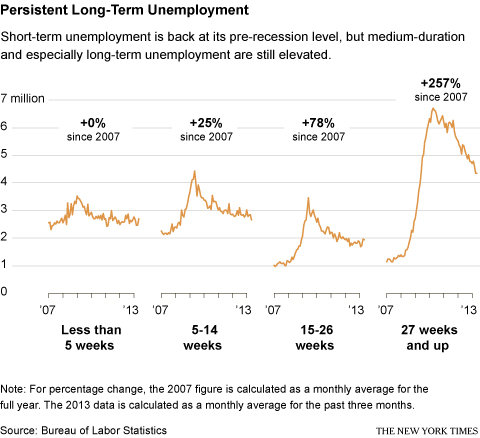Unconventional monetary policy “has been a significant success altogether,” Christine Lagarde, managing director of the International Monetary Fund, said in a lunchtime address. She said the efforts continued to yield benefits and should not be unwound too quickly.
Even for developing countries, which have sometimes criticized the efforts, the effects are “still positive,” she said. “Marginally, but still positive.”
But the conference, convened by the Federal Reserve Bank of Kansas City, underscored again the striking divide between academics, where skepticism is widespread about the benefits of the Fed’s asset purchases, and policy makers, where confidence is equally widespread.
The Fed has accumulated more than $3 trillion in Treasury securities and mortgage-backed securities, and since last December it has been expanding those holdings by $85 billion a month in an effort to drive down unemployment and promote growth.
The day began with a series of academic presentations criticizing the power of that approach. The most supportive said that the Fed’s purchases of Treasuries had little value, but that its purchases of mortgage-backed securities “likely have had beneficial macroeconomic effects.”
That study, by Arvind Krishnamurthy, an economist at Northwestern University, and Annette Vissing-Jorgensen, an economist at the University of California, Berkeley, still found little economic benefit in holding on to the mortgage bonds and Treasuries, a basic element of the Fed’s stimulus campaign. And it argued the Fed was undermining its own efforts by failing to articulate a clear plan for the purchases.
Policy makers tend to view these critiques as triumphs of theory over reality. They point to events in June as a kind of perverse evidence, noting that a wide range of interest rates jumped after the Fed’s chairman, Ben S. Bernanke, announced that the Fed intended to reduce its monthly asset purchases by the end of the year. The implication, they said, is that the purchases had been suppressing those rates.
“The paper doesn’t comport very well with the experience of the last couple of months,” said Donald L. Kohn, a fellow at the Brookings Institution and a former Fed vice chairman. “We’ve had a very broad set of asset price changes.”
Academic economists, in turn, say policy makers are claiming credit without presenting evidence.
While it seems clear, for example, that the Fed’s purchases of mortgage bonds have reduced interest rates on mortgage loans, some economists see evidence that current economic conditions have limited the benefits of lower mortgage rates. Banks have retained some of the benefit rather than passing it on to customers. Tighter qualification standards mean that many would-be borrowers cannot benefit from the lower rates. And those who are borrowing may not be inclined to spend more.
“Showing Fed affects interest rates doesn’t mean it automatically affects real activity,” one of those skeptics, Amir Sufi, an economist at the University of Chicago, said on Friday in an exchange of messages on Twitter. “Quantitative significance must be established.”
These debates, of course, are not merely academic. Fed officials are divided over when to begin cutting their monthly asset purchases — and when they do so, they must decide whether to buy fewer Treasuries, fewer mortgage bonds, or some combination.
Mr. Bernanke chose not to attend the conference as he prepares to step down in January, and no other Fed official spoke in his place.
Dennis P. Lockhart, president of the Federal Reserve Bank of Atlanta, said on Friday that he would support a cut when the Fed’s policy-making committee meets in September as long as there was no particularly bad news between now and then.
“I would be supportive in September as long as the data that comes in between now and then basically confirm the path we’re on,” he told CNBC.
Mr. Lockhart, however, does not hold a vote on the Federal Open Market Committee this year. One official who does, James Bullard, the Federal Reserve Bank of St. Louis president, told CNBC in a separate interview that he was undecided. “I don’t think we have to be in any hurry in this situation,” he said. “Inflation is running low, you’ve got mixed data on the economy, so I’d be cautious. I wouldn’t want to prejudge the meeting.”
Policy makers from developing countries urged the Fed to clarify its plans so they can prepare for potential disruptions. Low interest rates in the developed world have sent vast quantities of money sloshing into those countries. Ms. Lagarde said that net flows to those countries had risen by $1.1 trillion since 2008, about $470 billion above expectations based on long-term trends.
As rates rise, history suggests that some of the money may come sloshing back, with hugely disruptive consequences.
Investors already are selling foreign currencies and buying dollars in the expectation that the Fed will begin to decelerate its stimulus campaign, allowing the dollar to strengthen. The Indian rupee lost 4 percent of its exchange value in about a week, prompting the Reserve Bank of India to impose restrictions last week on the outflow of money.
Agustín Carstens, governor of the Bank of Mexico, said, “Advanced country central banks should mind the spillover effects of their actions.” He added, “Otherwise the crisis will be reactivated with new actors.”

Article source: http://www.nytimes.com/2013/08/24/business/economy/at-a-fed-conference-views-differ-sharply-on-stimuluss-effect.html?partner=rss&emc=rss








